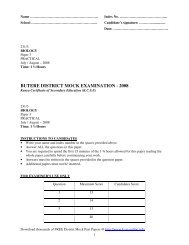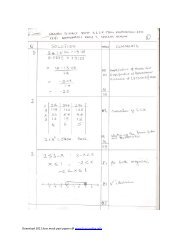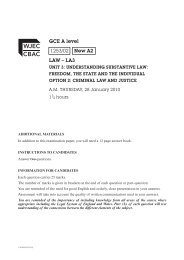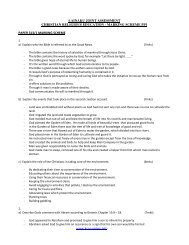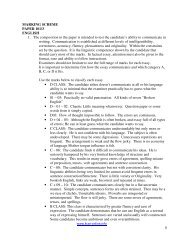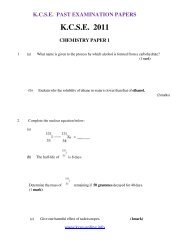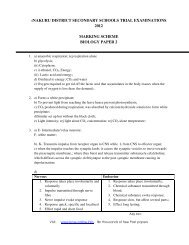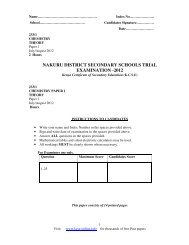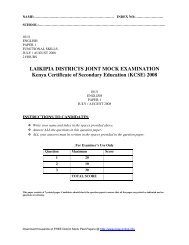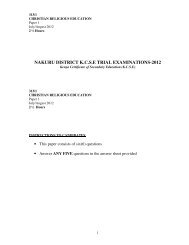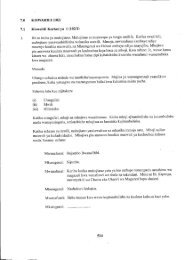b - kcse past papers | 2013 mock papers
b - kcse past papers | 2013 mock papers
b - kcse past papers | 2013 mock papers
Create successful ePaper yourself
Turn your PDF publications into a flip-book with our unique Google optimized e-Paper software.
312 / 1GEOGRAPHYSECTION A1. (a)• Mercury• Venus• Earth3x1=(3mks)(b)• Chances of another star approaching the sun are minimal.• High temperature material drawn from the sun or from the star would disperse rather thancondense• Does not explain where the sun and the passing star came from2x1=(2mks)2. (a)Time at town y on 75 0 w longitudeIf 1 0 = 4minsTherefore 75 0 = 4x75 = 5hours609-5= 4.00 a.m (2mks)(b)21 st March23 rd September3.(i)• Atmosphere• Hydrosphere2x1=(2mks)(ii)• Rocks rich in iron and magnesium• Made up of two layers- upper and lower mantle• Upper mantle is made up of hard rigid rocks• Inner mantle is made up of liquid ultra basic rocks• Mantle exceeds to about 2900km• Very high temperatures up to 5000 0 C• Convectional currents operate in this zone3x1=(3mks) Nrk*4. (a)• Continental drift is the movement or splitting of continents from original super continent (2mks)(b)• The jig- Saw fit of continental margins e.g. South America can fit into the western coast of Africa.• Similarities in climates i.e. all the four southern continents reveal signs of a period of large scaleglaciations some 250million years ago when they were closer and nearer to the south pole• Geological similarities between coasts of diff continents• Southern tips of continents reveal glaciation at one period of geology e.g. S. A, glacial deposits inthe Congo basin• Rift valley presence• Presence of fold mountains as continents collided (Mark any other relevant answer1x3=(3mks) Nrk*5. (a)(i) Barchans 1x1=1mks(ii) Prevailing winds(iii) Part marked x-horns 1x1=1(iv) Kalahari desert; and Sahara desertany 1x1=1 Nrk*(b)Download ksce <strong>mock</strong> <strong>past</strong> <strong>papers</strong> @ www.<strong>kcse</strong>-online.info
• Loose soil• Lack of vegetation2x1=(2mks) Nrk*SECTION B6. (a) i) Bearing 212 0 ± 1 0 ̌ ( 211 0 – 213 0 ) (2mks) Nrk*b) ii) Length of the road4.9km ± 1 0 (4.8-5.0 km) ̌̌ (2mks) Nrk*District boundary ̌Bambalocation ̌Silaloni CentrěDist(b)• Rectangle10cm x15cmS(1mk) Nrk*• District boundary ̌• Silaloni centeř• Bamba location ̌(b) Drainage• The area has few permanent rivers• Some rivers have dams• There are no major rivers• There are many waterholes• Rive Guruguru/Nyore and its tributaries forms dendritic drainage pattern• There are more rivers in the south than in the north• There is a disappearing river on the northwestern corner of the map.• There is a seasoned river around Silaloni. (Accept any other relevant answerany 4x1=(4mks) Nrk*(c)• Quarrying-quarries/rock out crop• Trading-shops• Transportation- roads(Any 3x1=3mks) evidence a must to score Nrk*(d) (i)• Thickets• ScrubDownload ksce <strong>mock</strong> <strong>past</strong> <strong>papers</strong> @ www.<strong>kcse</strong>-online.info2
• Scattered trees• Forestany 3x1=(3mks) Nrk*(ii)• It enables student to collect first hand information about vegetation in the filed• Students are able to study different types of vegetation in the field• Students are able to study different uses of vegetation in the field• Student are able to apply skills learnt in the classroom in the filed Any 3x1=(3mks) Nrk*accept any other relevant answer(iii)• To know the uses of various types of vegetation• To know methods of conserving the vegetation• To know how to exploit the vegetation sustainablyAny 2x1=(2mks) accept any other relevant answer Nrk*(iv)• Covering long distances/large area• Sparse settlements / four respondents• Few roads• Attack by wild animals• High temperaturesany 2x1=(2mks) Nrk*7. (a)P-Ndoto/NyiruQ-MathewsR-RuwenzoriS-Usambara4 x 1 Nrk*(b)• Normal fault• Reverse fault• A tear, shear or slip fault• A thrust fault• An anticlinal fault3 x1 Nrk*(c)̌Layers of rock are subjected tocompression forcě̌Parallel faults develop in the line ofweaknesš / reverse faults develop ̌Download ksce <strong>mock</strong> <strong>past</strong> <strong>papers</strong> @ www.<strong>kcse</strong>-online.info3
̌The middle part graduallysinks / subsides forming thefloor of the Rift Valley ̌Text – 3 mksb) Diagrams –3mks(d)6 mks Nrk*• Faulting causes disjointing of the land leading to disruption of communication lines, water etc• Faulting may cause sinking of land leading to loose of property and life.• Faults are sources of minerals, which form in them, as they are associated with low basin.• At the base of the faults scarps, springs usually occur. These may attract settlement• Hot springs and geysers associated with faulting can be source of geothermal power• Faults related features attract tourists therefore earning foreign exchange• Faults lakes act as fishing ground e.g. Lake Bango.4x2=(8mks) Nrk*(e) (i)• Gives ample time to each activity• Reduces tendency to waste time• It provides an estimate of the time required for the study• It provides a basis for evaluating the field work while it is still in progress• It provides a frame work that guides the researcher to remain within the scope of the topic(ii)• Rift valley• Fault scap/escapement/scarp slope• Block/horst mountain• Tilt blocks2x1=(2mks) Nrk*8. (a)Lithosphere(b) (i)• It contains most of the weather making constituents• It is also the life supporting layer since within it people are able to live and breath freely• Within the troposphere temperature decreases with increase in height• Pressure in this part fall with increase in height• Wind speed increase with increase in height4x1 =(4mks) Nrk*(ii)• The core is the inner most part of the earth• It is divided into two parts. There are the outer core and the inner core• The outer core is mainly made up of the minerals iron and nickel• The inner core is mainly made up of iron• The outer core is of molten rock material while the inner core is solid• The rocks that make up the outer core are less dense than those of the inner core. The outer corerocks have a density of 10.5gm/cc while the inner core rocks have an average density of 17.0gm/cc4x1=(4mks) Nrk*(c)• Mechanically formed- These are formed when eroded rock materials are transported by agents oferosion and deposited in layers either on land or in the sea. Pressure from overlying layers makethe material to be compressed and compacted to form a rockDownload ksce <strong>mock</strong> <strong>past</strong> <strong>papers</strong> @ www.<strong>kcse</strong>-online.info4
• Organically formed- These are formed when remains of previously existing plants and animals areaccumulated over a long period of time to form layers. With time pressure from overlying materialcompress these remains into a rock.• Chemically formed- These are formed after dissolving of minerals from pre-existing rocks. Thesesolutions are precipitated through chemicals reactions or through evaporation. The precipitatesthrough chemical reactions or through evaporation. The precipitates accumulates in layers and getcompressed with time to form a rock2x3= (6mks) Nrk*(d)• They are harder than original rock• They are more resistant to erosion• They are non porous rock• Accept any other relevant answer 3x1=(3mks) Nrk*(e) (i)• To find out the colour of the rocks• To find out what type of rocks are found there• To find out the hardness of the rocksDownload ksce <strong>mock</strong> <strong>past</strong> <strong>papers</strong> @ www.<strong>kcse</strong>-online.info53x1=(3mks) Nrk*(ii)• Digging to extract the covered rocks• Feeling or touching to determine the texture• Observing various rocks• Interviewing the people in the vicinity• Collecting samples of the rock• Photograph taking• Administering questionnaires2x1=(2mks) Nrk*(iii)• Breaking rock samples• Observing of the rocks• Collecting rock samples• Digging to access rocks buried underneath• Labelling rock samples3x1= (3mks) Nrk*9. (a) (i)An ocean is an extensive mass of saline water occupying a large basin between continentswhereas a sea is a large body of saline water on the continental margins Nrk*(ii)• Density of the oceans water• Meeting of surface current• Wind• shape of land masses• Earths rotation• Difference in temperature3x1=(3mks) Nrk*(b) (i)• It is caused by dissolved mineral salts• A lot of salt is also added to the oceans from rivers which have dissolved it from the land• Sea water also dissolves salt directly from the rocks it is in contact with• Volcanic materials and the ocean floor contribute some amount of salt as well2x1=(2mks) Nrk*(ii)• Perigean tides• Apogean tides
• Spring tides• Neap tides3x1=(3mks) Nrk*(c)• Fishing-The sheltered waters of the fiords offer suitable sites for the breeding of fish hence fishingcan be carried out• Oceans provided cheap route ways connecting continents• Ocean deposits lead to formation of oil and natural gas, which have been extracted by humanbeings• The rise and fall of ocean water (Tides) can be used to generate electricity (Tidal power)• Common salt and magnesium are exploited from oceans by some countries like China and India4x2=8mks Nrk*(d) (i)• Formulation of objectives and hypothesis• Dividing students into working groups• Assembling working tools and equipments• Reading from secondary sources• Preparing a working schedule• Seeking permission from relevant authorities• Pre-visit the are before the actual study3x1=(3mks) Nrk*(ii)• Wave cut platform• Raised beach• Raised caves• Mud flats• Spits• Offshore bars• Old cliffs• New cliff lineNrk*10. (a) (i)• Structure• Texture• Colour• Permeability• Porosity3x1=(3mks) Nrk*(ii)• Soil catena is the sequential arrangement of soil along a slope, while soil profile refers to thevertical through a soil showing a sequence of horizontal layers (Horizons) from the surface downto the parent rock.2mks Nrk*(b)• Shifting cultivation- It involves clearing of vegetation by burning it. This lay land bare and hencepredisposed to heavy tropical rainfall that sweeps away top soils.• Cultivating very steep slopes and along riverbanks this loosens soil aggregates making it possiblefor soil particles to be removed easily.• Mono cultural cropping-This practice encourages a single crop to siphon specific mineral nutrientsfrom the soil. This exhausts soil of that particular mineral salt making it less capable of supportingother plants. The soil is hence left exposed to agents of erosion• Multi-cropping- Several crops growing on the same piece of land at the same time remove mineralnutrients from the soil at a faster rate than they are replaced by fertilizers. Rapid decline in soilfertility weakens soil structures and makes them liable to erosionDownload ksce <strong>mock</strong> <strong>past</strong> <strong>papers</strong> @ www.<strong>kcse</strong>-online.info6
• Extensive cultivation of land- Continuous cultivation of land breaks up soil crumbs. Loose soilparticles hence become vulnerable to erosion by moving water and wind• Defforestation4x2=(8mks) Nrk*(c) (i)• Collect and prepare the required instruments• Seek permission from authorities• Read about soils from books and journals• Write out the objectives of the study and hypothesis• Obtain writing materials• Prepare tables/sketch maps for recording the data collected• Prepare a working schedule3x1=(3mks) Nrk*(ii)• I would use a polythene bag to (i) Collect samples of soil and related rock particles for furtheranalysis in the laboratory. It can also be used to store studied samples of soil and rocks for futurereferences.• While tape measure can be used to measure out distances between difference places chosen forcollection of samples . The tape measure will also ensure that the sampling of the places of study isevenly distributed2x1 =(2mks) Nrk*(iii)• Note taking• Photographing• Drawing• Filling of tables3x1=(3mks) Nrk*(d)• Weather changes e.g. rain• Hostile animals e.g. snake• Hostile neighboursNrk*Download ksce <strong>mock</strong> <strong>past</strong> <strong>papers</strong> @ www.<strong>kcse</strong>-online.info7



